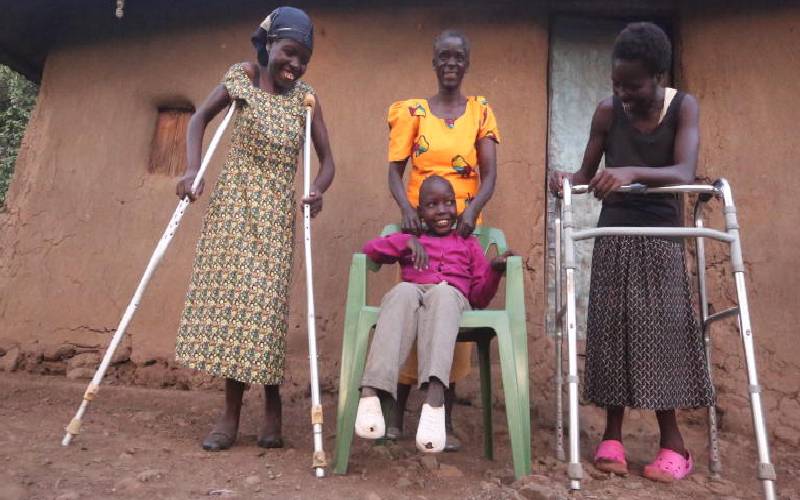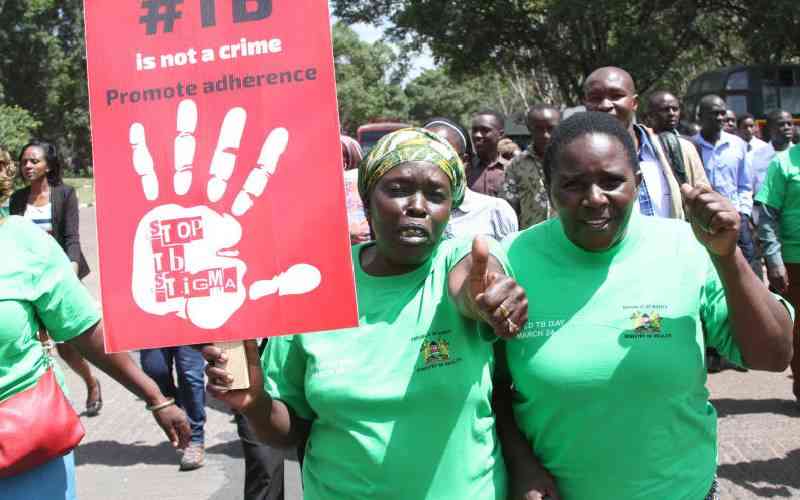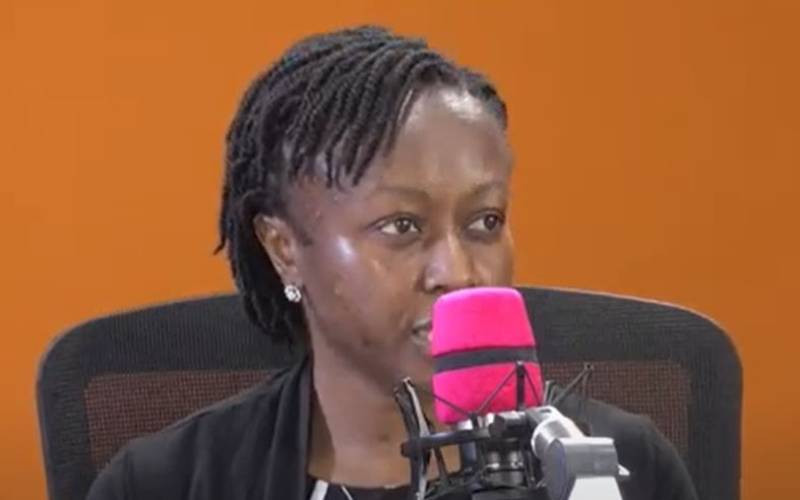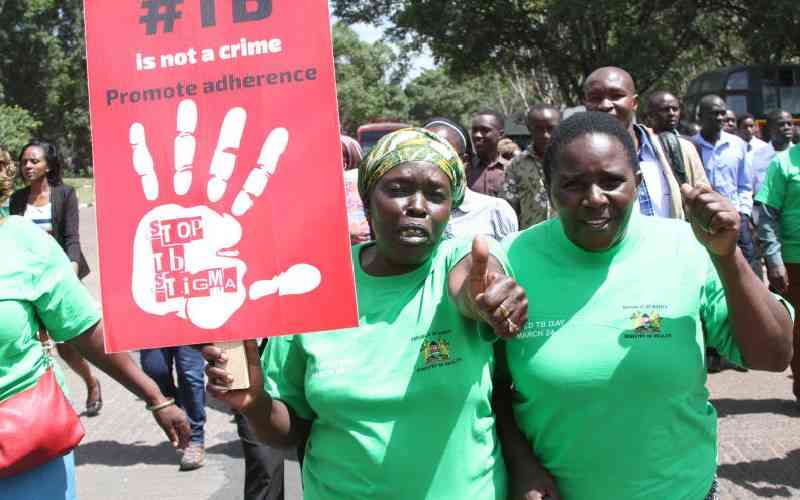
Mary Achieng' (centre) with her children Nancy Akinyi (left), Peter Onyango and Winnie Apiyo at their home in Awasi Kisumu county. [Collins Oduor, Standard]
When you ask the 23-year-old women to name at least one thing on their wish list, without missing a beat, they tell you, rather bashfully, that it is to walk without support and to feel what it is like to be pain-free. Nancy Akinyi uses crutches, while Winnie Apiyo uses a walker. Being identical twins, they not only look alike but wear identical startling smiles.
Orphaned when they were barely three, their grandmother Mary Achieng has been their caretaker to date. And Mary’s fervent wish throughout the years has been much like her grandchildren’s. That they would someday stand, walk and play like their peers.
But instead, as the years go by, Mary worries that their condition is deteriorating even after the girls underwent two sessions of correctional surgeries.
Medical report indicates that the twins were born with Idiopathic In?ammatory Myopathies (IIM) a rare disorder with primary features of muscle weakness and inflammatory lesions. It is also characterised by pain.
“Our parents never saw us walk. We could barely move when they passed on. All I remember is that they were very supportive,” Winnie says wryly.
Two years ago, Nancy’s perpetual pain was made worse after she bore her son who unfortunately son bears the same condition.
The three now entirely depend on Mary for care and support; a task that though weighs heavily on the grandmother and now great grandmother is one she can’t relinquish to anyone else.
Bernard Ondemo, an occupational therapist at Kisumu County Referral Hospital explains that an Idiopathic Inflammatory Myopathy is a group of disorders characterised by irritation of the muscles used for movement. The skeletal muscles.
“Most cases of IIM are sporadic. They occur in people with no history of the disorder in their family. However, several people with idiopathic inflammatory myopathy have had close relatives with autoimmune disorders.”
Autoimmune diseases occur when the immune system malfunctions and attacks the body’s tissues and organs.
“A small percentage of all cases of Idiopathic Inflammatory Myopathy have been reported to run in families; however, the condition does not have a clear pattern of inheritance,” he explains.
Multiple genetic and environmental factors likely play a part in determining the risk of developing this disorder. Additionally, inheriting a genetic variation linked with idiopathic inflammatory myopathy does not mean that a person will develop the condition. Exposure to certain medications and exposure to ultraviolet light have been identified as possible environmental triggers, but most risk factors for this condition remain unknown. In fact, the term “idiopathic” implies that the specific cause of the disorder is unknown.
“It is likely that specific genetic variations increase a person’s risk of developing the condition, exposure to certain environmental factors trigger the disorder,” Bernard notes.
So rare is the condition that it affects about 2 to 8 out of a million people.
“The condition usually appears in adults between ages 40 and 60 or in children between ages 5 and 15, though it can occur at any age. When one develops the condition, there is drastic muscle weakness, which develops gradually over a period of weeks to months or even years. Other symptoms include joint pain and general tiredness or fatigue,” says Bernard.
There are several forms of idiopathic inflammatory myopathy, including polymyositis, dermatomyositis, and sporadic inclusion body myositis.
Bernard reckons that from observation and from the twins’ medical records, they might have the two if not the three forms of IIM, but further tests would conclusively ascertain that.
Polymyositis and dermatomyositis forms of IIM involve weakness of the muscles closest to the centre of the body such as the muscles of the hips and thighs, upper arms, and neck.
“Patients with these forms of idiopathic inflammatory myopathy may find it difficult to climb stairs, get up from a seated position or lift items above their head. In some cases, muscle weakness may make swallowing or breathing difficult.”
Peter, Nancy’s son started experiencing these difficulties at just nine months, and currently without a wheelchair, he has to be carried around.
“If there is no one to carry him, he can stay at one spot for hours,” Mary says.
For unknown reasons, polymyositis and dermatomyositis are about twice as common in women as in men, while sporadic inclusion body myositis is more common in men.
Daily management
IIM has no cure but many of the symptoms can be treated as appropriate. Treatment options include medication, physical therapy and rest. Occupational therapy is key in the management of IIM. As years go by, the deterioration of muscles progresses making it difficult for one to carry out daily activities. Occupational therapy is, therefore, necessary to train the muscles and keep them in good condition as long as possible.
“Activities that strengthen weakened muscles are recommended. We then teach the patients some energy conservation techniques so that their body movement is more efficient. We evaluate the patient and recommend the best ways the client can maintain their health and function through self-care, work and play. We also train the client to use devices and mobility aids,” says Bernard.
To make everyday life easier for the affected, appropriate environmental modification measures, especially to clients using wheelchairs or walkers, are recommended to make mobility easier.
“It is also best to have a corset or body jacket to provide better support and balance to the spine in case of abnormal curvature of the spine.”
 The Standard Group Plc is a multi-media organization with investments in media platforms spanning newspaper print
operations, television, radio broadcasting, digital and online services. The Standard Group is recognized as a
leading multi-media house in Kenya with a key influence in matters of national and international interest.
The Standard Group Plc is a multi-media organization with investments in media platforms spanning newspaper print
operations, television, radio broadcasting, digital and online services. The Standard Group is recognized as a
leading multi-media house in Kenya with a key influence in matters of national and international interest.











